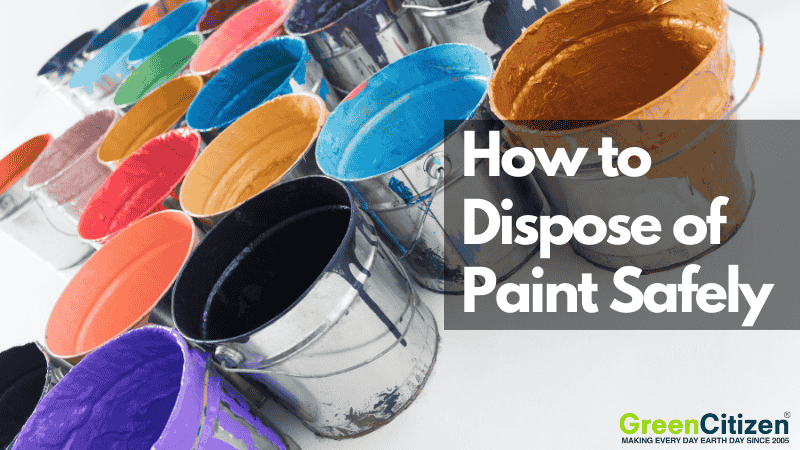You just finished painting the guest room—or maybe moved houses—and now you’re stuck wondering how to dispose of paint properly.
There’s that half-full can of blue latex paint, a couple of spray paint cans from an old art project, and maybe even a rusty gallon of acrylic from who-knows-when. You can’t just throw them in the trash. They’re considered hazardous waste, and dumping them can lead to fines or environmental harm.
And if you’ve ever Googled “paint disposal near me,” you know the rules aren’t always clear.
This guide breaks it all down. You’ll learn:
- Where to dispose of paint near you
- How to handle old paint, including latex, oil-based, and aerosol cans
- Whether your paint can be recycled, reused, or needs special handling
We’ll help you clean up your garage without risking the planet—or breaking the law.
Key Takeaway: How to Dispose of Paint Responsibly
You can dispose of paint safely by drying out latex and acrylic before placing them in the trash, while oil-based and aerosol paints must go to hazardous waste facilities. Empty paint cans may be recyclable. Always check local programs or PaintCare drop-offs for safe, legal paint disposal near you.
How to Dispose of Paint (Latex, Oil-Based, Acrylic, Spray Paint Disposal Methods)
Paint disposal depends on the type of paint. You can dry out latex and acrylic paint and throw them in the trash or reuse them if still fresh. But oil-based and spray paints are considered hazardous waste and must be dropped off at certified disposal facilities.
Some recycling centers accept leftover paint, especially if the can is unopened or nearly full. Never pour liquid paint down the drain or toss it in the trash—it’s harmful to the environment and may violate local waste laws.
How to Dispose of Latex Paint
You can dispose of latex paint by drying it out completely and placing it in the trash. Latex paint is water-based and not classified as hazardous waste once solid. However, never pour liquid latex paint down the drain—it can damage plumbing and pollute local waterways.
Latex paint contains compounds like titanium dioxide and ethylene glycol. While these are less toxic than chemicals in oil-based paint, they can still be harmful if the paint is dumped down drains or left in liquid form.

Latex Paint Disposal Method
- For small amounts: Leave the lid off and let the paint air-dry in the can.
- To speed up drying: Mix in cat litter, sawdust, shredded newspaper, or paint hardener.
- Once fully dry and solid: Dispose of it with your regular household trash.
Tip: Some recycling centers accept leftover or usable latex paint. Check your local paint disposal or recycling program.
How to Dispose of Oil-Based Paint (Hazardous Waste Guidelines)
Oil-based paint is considered hazardous waste and must be taken to a certified disposal facility. It contains high levels of volatile organic compounds (VOCs) such as toluene, xylene, and benzene, which can release toxic fumes and contaminate soil and groundwater if thrown away or poured down the drain.
Unlike latex paint, you CANNOT dry out oil-based paint and toss it in the trash—doing so may violate local and federal waste laws.
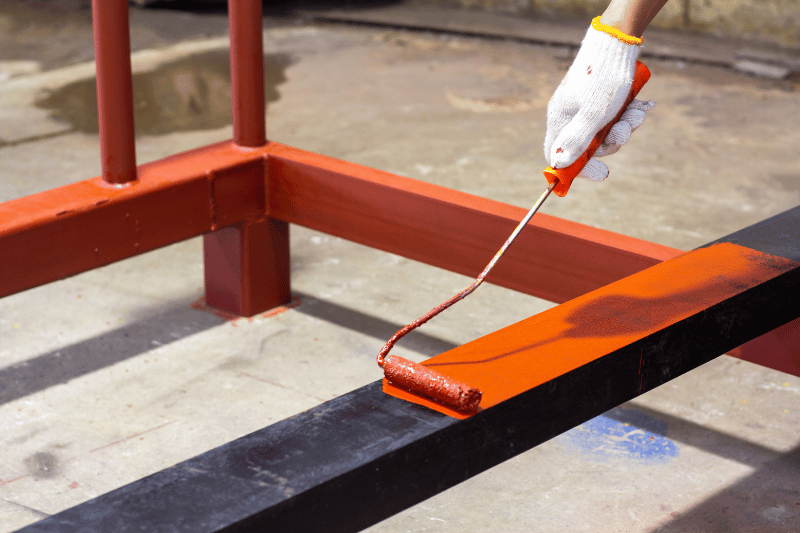
Oil-Based Paint Disposal Method
- Never throw oil-based paint in the trash or down the drain.
- Bring it to a Household Hazardous Waste (HHW) facility in your area. Most cities and counties operate HHW drop-off programs for leftover paint.
- Check your local government website or public works department for disposal events and facility hours.
- Use PaintCare’s drop-off locator if you’re in a participating state.
- Retailers like Lowe’s and Home Depot may accept leftover oil-based paint through local partnerships or special collection days.
- Sherwin-Williams stores in select regions offer their own take-back programs—call ahead to confirm availability.
Pro Tip: If you’re in a PaintCare state (like California, Colorado, or New York), you can drop off both oil-based and latex paints at participating stores—even if you didn’t buy it there.
How to Dispose of Acrylic Paint Safely (Craft and Art Paint Guidelines)
You can dispose of acrylic paint by drying it out completely and placing it in your household trash. Like latex paint, acrylic is water-based, but it contains plastic polymers and pigments that can be harmful to the environment if poured down the drain or thrown away while still liquid.
Acrylic paints are often used in crafts, model-making, and art projects. While they’re less toxic than oil-based paints, they’re not entirely safe for waterways or soil, especially when wet.
Most local waste authorities recommend solidifying acrylic paint before disposal, and some municipalities treat even small quantities as household hazardous waste.

Acrylic Paint Disposal Method
- For small amounts: Let the paint air-dry in its container or on newspaper.
- To speed it up: Mix in absorbents like kitty litter, sawdust, or shredded paper.
- Once fully dry and solid: Dispose of the hardened paint with your regular household trash (confirm with local sanitation guidelines).
- Check with local programs: Some cities and counties offer drop-off points for leftover acrylic paint, particularly if the container is unopened or nearly full.
💡 Tip: Although it’s water-based, acrylic paint contains plastic binders and heavy metal pigments that can pollute waterways. Art schools and environmental agencies recommend wiping excess paint onto a disposable surface and letting rinse water evaporate before scraping and discarding the solids in the trash.
How to Dispose of Spray Paint and Aerosol Cans Safely
Spray paint and aerosol paint cans must be disposed of as hazardous waste unless they are completely empty. These cans are pressurized and often contain flammable propellants and leftover solvents that make them dangerous to puncture, burn, or throw in the trash.
Even when labeled “non-toxic” or “low VOC,” partially full aerosol cans can release harmful chemicals into the air or groundwater if improperly handled.
That’s why both the EPA and most local hazardous waste programs treat spray paint as household hazardous waste (HHW).
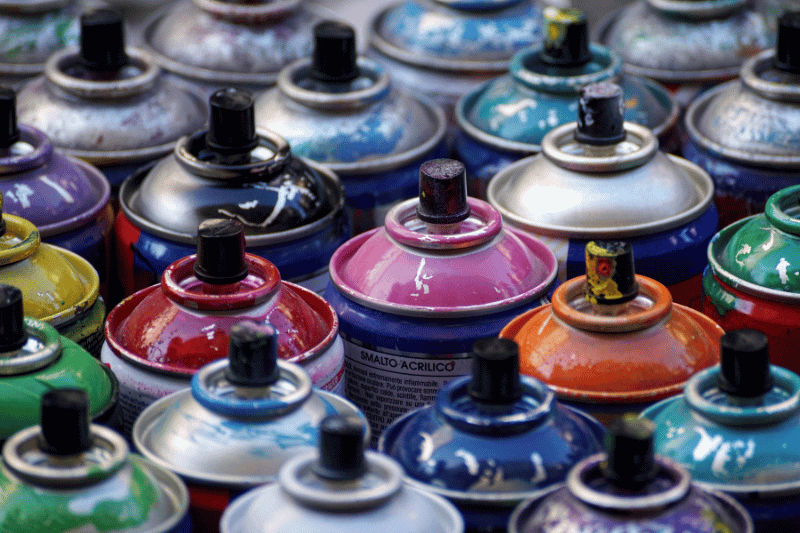
Spray Paint and Aerosol Can Disposal Method
- If the can is completely empty:
- Most curbside recycling programs accept empty aerosol cans as long as the nozzle is intact and the can is not punctured or crushed.
- Place it with your metal or mixed recyclables (check with your local recycler).
- If the can still contains paint or propellant:
- Do not throw it in the trash or recycling bin.
- Take it to a certified Household Hazardous Waste (HHW) collection site.
- Some paint retailers or municipal collection events accept aerosol cans—call ahead to confirm.
- Never puncture, burn, or incinerate aerosol cans.
- Pressurized containers can explode when exposed to heat or improper handling.
💡 Note: Spray paint cans are classified as universal waste under the U.S. EPA’s hazardous waste rules. This means they fall under special disposal regulations in many states, especially California. Always check your local or state hazardous waste program for specific guidance before discarding aerosol products.
Where to Dispose of Paint Near You (Drop-Off, Hazardous Waste & Retail Options)
You can dispose of leftover paint near you at local recycling centers, hazardous waste drop-off sites, and participating retailers.
Many cities run paint recycling programs or partner with national take-back initiatives like PaintCare.
Whether you’re dealing with dried latex paint or leftover oil-based paint, the right disposal method depends on the type—and your location.
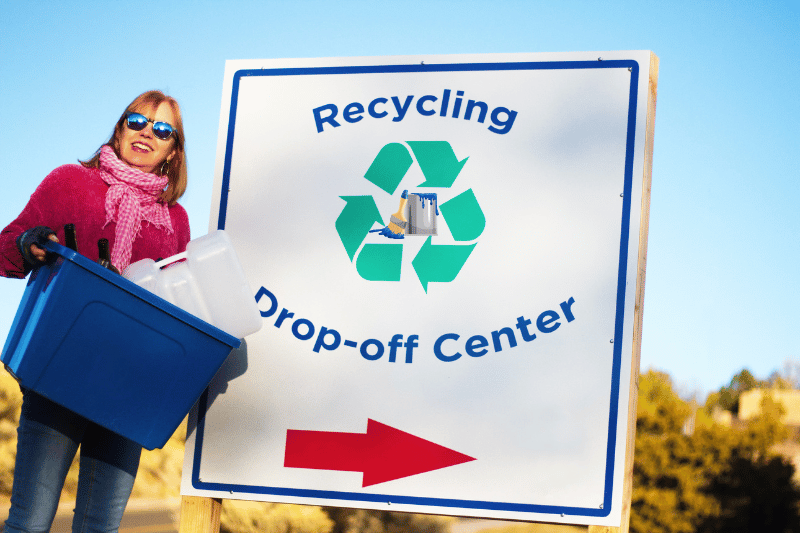
1. Local Paint Drop-Off Locations
Most cities and counties offer public paint drop-off sites.
For example, Recology in San Francisco allows residents to drop off leftover paint at designated household hazardous waste (HHW) centers.
Many recycling centers also accept dried latex paint, though rules vary by region. Check your city’s waste management website or search “paint disposal near me” to find local drop-off points.
You can also donate usable paint to local schools, theaters, or community organizations that welcome surplus supplies.
2. Household Hazardous Waste (HHW) Facilities
Oil-based paints are classified as hazardous waste and must be taken to a certified HHW facility. Most cities run these programs year-round or host seasonal disposal events.
Use your local public works website or state-run environmental agency portal to locate facilities near you. If you’re in California, CalRecycle and PaintCare are two of the most reliable resources.
3. Hardware Stores
Many major hardware retailers participate in paint take-back programs.
Home Depot, Lowe’s, and Sherwin-Williams often accept leftover paint through partnerships with PaintCare, which operates in states like California, Colorado, New York, and Oregon.
Use PaintCare’s locator tool to find participating stores near you. Always call ahead to confirm your local store’s policy and accepted paint types.
Tip: Check Local Laws Before Dumping
Improper paint disposal may violate environmental regulations. Always verify disposal guidelines on your city’s sanitation or environmental agency website—especially if you’re handling spray paint, oil-based products, or large quantities.
How to Prepare Paint for Disposal (Checklist for Safe and Legal Handling)
Before you dispose of any paint, it’s important to prepare it properly based on the type. Whether it’s latex, acrylic, or oil-based, improper handling—like throwing away liquid paint or rinsing it down the drain—can cause environmental harm and legal issues.
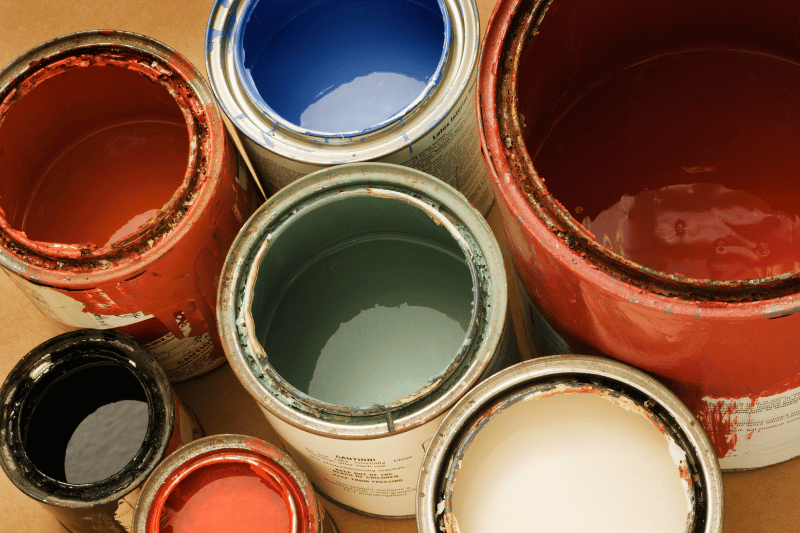
Use this checklist to ensure your paint is safe to discard or recycle.
✔️ 1. Identify the Paint Type
- Latex and acrylic paint are water-based and can be dried and discarded if local laws allow.
- Oil-based paint is always considered hazardous waste and must be taken to a certified HHW facility.
- Spray paint and aerosol paint cans must be fully empty before recycling; otherwise, they also go to hazardous waste centers.
✔️ 2. Ensure the Paint Is Fully Dry
For latex or acrylic paints:
- Small amounts: Let the can sit open in a well-ventilated area.
- Larger amounts: Mix in kitty litter, sawdust, or a commercial paint hardener.
- Paint must be fully hardened before placing it in the trash.
🧠 Tip: Some local recycling programs accept dried paint cans as scrap metal. Check your city’s curbside recycling guidelines.
✔️ 3. Handle Hardened Paint Properly
- If the paint is already dried or solidified: you can usually throw it away in household trash (unless oil-based).
- If it’s semi-soft: Let it dry completely before disposal.
- Never attempt to reactivate or dilute partially dried oil-based paint—it must go to hazardous waste disposal.
✔️ 4. Never Pour Paint Water Down the Drain
Paint rinse water contains plastic polymers, pigments, and in some cases heavy metals. Even though latex or acrylic paint is water-based, rinsing brushes in a sink can pollute water systems.
✅ What to do instead:
- Wipe excess paint off brushes before rinsing.
- Let rinse water sit until evaporated, then scrape and discard the residue in the trash.
How to Store Leftover Paint Safely (Keep Paint Fresh and Prevent Spills)
Proper paint storage extends shelf life, prevents safety hazards, and keeps leftover paint reusable for future touch-ups. Whether it’s latex or oil-based, improper storage can lead to leaks, dried-out paint, or even fire risks in extreme heat.
The U.S. Consumer Product Safety Commission recommends storing paint in a cool, dry, well-ventilated area away from flames or heat sources. Paint cans may also release VOCs (volatile organic compounds) over time, especially if not sealed tightly.
Best Practices for Storing Paint at Home
- Keep paint in a cool, dry location: Avoid garages or attics that get hot in summer or freeze in winter. Ideal temperature: 60–80°F (15–27°C).
- Seal the can properly: Use a rubber mallet to gently tap the lid shut. Avoid metal hammers—they can warp the lid and cause air leaks.
- Label clearly for future use: Include the paint brand, color name, date of purchase, room used, and any custom mix codes.
- Wipe excess paint from the rim before sealing: Prevents the lid from sticking and ensures a better seal.
- Store cans upright and off the floor: Place on a shelf or board to avoid rust from moisture on concrete surfaces.
Organize by room or project: Use masking tape, a marker, or a label maker to mark where each can was used.
🧠 Tip: Check Before Reuse
Latex paint lasts about 2–10 years, while oil-based can last up to 15 years if sealed and stored properly. Before using, stir thoroughly and test on scrap cardboard to ensure color and consistency haven’t changed.
How to Dispose of Paint Cans
Empty paint cans can usually be recycled with other metal or plastic containers, while cans that still have leftover paint must be taken to a hazardous waste facility. Never throw partially full cans in the trash or pour paint down the drain—both actions can harm the environment and may violate local waste laws.

Can You Recycle Empty Paint Cans?
Yes, but they don’t need to be spotless. Recycling programs understand that paint cans almost always have some dried residue inside. What matters is that there’s no liquid paint left. A thin film or dried layer of paint is acceptable.
- Metal paint cans are often accepted in curbside recycling programs once all liquid paint is removed.
- Plastic paint cans (HDPE #2) may also be recyclable, depending on your municipal program.
- Remove labels and let lids air out to improve acceptance.
🧠 Good to Know: The EPA and most local recycling agencies only require that cans be completely dry—not perfectly clean.
Responsible Paint Disposal and Environmental Impact
Improper disposal of old paint can have serious environmental consequences. Paints, especially oil-based paint, contain hazardous chemicals like volatile organic compounds (VOCs) that can contaminate soil, water, and air.
When these harmful substances are thrown away improperly or dumped down drains, they can cause lasting damage to ecosystems and even pose health risks to communities.
That’s why it’s essential to prioritize responsible paint disposal. By taking leftover paint to local recycling programs or hazardous waste collection centers, you prevent these toxins from entering the environment.
Many communities offer convenient options for paint disposal near me, making it easier than ever to safely dispose of old paint. Whether it’s dropping off unused cans or ensuring oil-based paint is handled by a hazardous waste facility, every effort contributes to a healthier planet.
Remember, proper disposal isn’t just about getting rid of paint—it’s about protecting the environment for future generations.
So, the next time you’re wondering how to deal with old paint, be sure to seek out responsible options and keep harmful chemicals out of landfills and waterways.
Frequently Asked Questions (FAQ)
Yes, in many places it is illegal to throw liquid paint in the trash. Most cities and states classify oil-based paint and aerosol paint cans as hazardous waste, and improper disposal can result in fines or penalties. Even latex and acrylic paint cannot go in the trash while liquid — it must be completely dried first.
Once opened, paint can last 2 to 5 years if properly sealed and stored in a cool, dry place. Latex and acrylic paints generally last longer than oil-based paints. To check if the paint is still usable, stir it well and test a small amount on a surface. If the texture is smooth and there’s no bad odor, it’s likely still good.
To harden paint for disposal, add absorbent materials like kitty litter, sawdust, or a commercial paint hardener to the can. Stir the mixture until it thickens. Once the paint has solidified, it’s safe to throw away with regular trash. Be sure the paint is completely dry before disposing of it to prevent leakage.
If the paint is dried out or hardened, you can safely dispose of the old paint cans with your regular trash. However, if there is still paint inside, take the cans to a household hazardous waste facility or a designated paint drop-off center. Some areas also have paint recycling programs available.
Painted tin cans can be recycled, but only if they are completely dry and free of any residual paint. Many curbside recycling programs accept metal paint cans, provided they are clean. For cans with wet or partially dried paint, take them to a hazardous waste facility for proper disposal.
Paint does not decompose easily, especially if it contains hazardous chemicals. Oil-based paint and other solvent-based paints can remain harmful for decades, while water-based paints like latex decompose more quickly. Still, improper disposal can lead to long-term environmental damage, so always follow proper disposal methods.
Yes, certain types of paint, particularly oil-based paint, are considered toxic waste due to their hazardous chemicals like VOCs (volatile organic compounds). These chemicals can pollute the environment if improperly disposed of. Water-based paints like latex are less toxic but still require careful disposal to avoid contamination.
Paint can remain harmful as long as it contains active hazardous chemicals, particularly in the case of oil-based paints. Leftover VOCs in the paint can continue releasing harmful fumes for years. Even dried paint can cause harm if it contains lead or other toxins, especially when disposed of improperly.
